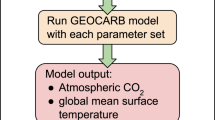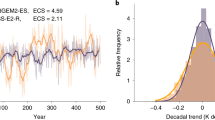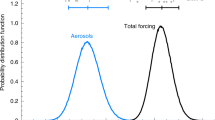Abstract
Global energy budget constraints1,2,3 suggest an equilibrium climate sensitivity around 2 °C, which is lower than estimates from palaeoclimate reconstructions4, process-based observational analyses5,6,7, and global climate model simulations8,9. A key assumption is that the climate sensitivity inferred today also applies to the distant future. Yet, global climate models robustly show that feedbacks vary over time, with a strong tendency for climate sensitivity to increase as equilibrium is approached9,10,11,12,13,14,15,16,17,18. Here I consider the implications of inconstant climate feedbacks for energy budget constraints on climate sensitivity. I find that the long-term value of climate sensitivity is, on average, 26% above that inferred during transient warming within global climate models, with a larger discrepancy when climate sensitivity is high. Moreover, model values of climate sensitivity inferred during transient warming are found to be consistent with energy budget observations1,2,3, indicating that the models are not overly sensitive. Using model-based estimates of how climate feedbacks will change in the future, in conjunction with recent energy budget constraints1,19, produces a current best estimate of equilibrium climate sensitivity of 2.9 °C (1.7–7.1 °C, 90% confidence). These findings suggest that climate sensitivity estimated from global energy budget constraints is in agreement with values derived from other methods and simulated by global climate models.
This is a preview of subscription content, access via your institution
Access options
Access Nature and 54 other Nature Portfolio journals
Get Nature+, our best-value online-access subscription
$29.99 / 30 days
cancel any time
Subscribe to this journal
Receive 12 print issues and online access
$209.00 per year
only $17.42 per issue
Buy this article
- Purchase on Springer Link
- Instant access to full article PDF
Prices may be subject to local taxes which are calculated during checkout

Similar content being viewed by others
References
Otto, A. et al. Energy budget constraints on climate response. Nat. Geosci. 6, 415–416 (2013).
Lewis, N. & Curry, J. A. The implications for climate sensitivity of AR5 forcing and heat uptake estimates. Clim. Dynam. 45, 1009–1023 (2015).
Kummer, J. R. & Dessler, A. E. The impact of forcing efficacy on the equilibrium climate sensitivity. Geophys. Res. Lett. 41, 3565–3568 (2014).
Royer, D. L. Climate sensitivity in the geologic past. Annu. Rev. Earth Planet. Sci. 44, 277–293 (2016).
Fasullo, J. T. & Trenberth, K. E. A less cloudy future: the role of subtropical subsidence in climate sensitivity. Science 338, 792–794 (2012).
Sherwood, S. C., Bony, S. & Dufresne, J.-L. Spread in model climate sensitivity traced to atmospheric convective mixing. Nature 505, 37–42 (2014).
Tan, I., Storelvmo, T. & Zelinka, M. D. Observational constraints on mixed-phase clouds imply higher climate sensitivity. Science 352, 224–227 (2016).
Forster, P. M. et al. Evaluating adjusted forcing and model spread for historical and future scenarios in the CMIP5 generation of climate models. J. Geophys. Res. Atmos. 118, 1139–1150 (2013).
Geoffroy, O. et al. Transient climate response in a two-layer energy-balance model. Part II: representation of the efficacy of deep-ocean heat uptake and validation for CMIP5 AOGCMs. J. Clim. 26, 1859–1876 (2013).
Senior, C. A. & Mitchell, J. F. B. Time-dependence of climate sensitivity. Geophys. Res. Lett. 27, 2685–2688 (2000).
Winton, M., Takahashi, K. & Held, I. M. Importance of ocean heat uptake efficacy to transient climate change. J. Clim. 23, 2333–2344 (2010).
Armour, K. C., Bitz, C. M. & Roe, G. H. Time-varying climate sensitivity from regional feedbacks. J. Clim. 26, 4518–4534 (2013).
Li, C., von Storch, J.-S. & Marotzke, J. Deep-ocean heat uptake and equilibrium climate response. Clim. Dynam. 40, 1071–1086 (2013).
Rose, B. E. J. et al. The dependence of transient climate sensitivity and radiative feedbacks on the spatial pattern of ocean heat uptake. Geophys. Res. Lett. 41, 1071–1078 (2014).
Andrews, T., Gregory, J. M. & Webb, M. J. The dependence of radiative forcing and feedback on evolving patterns of surface temperature change in climate models. J. Clim. 28, 1630–1648 (2015).
Gregory, J. M. & Andrews, T. Variation in climate sensitivity and feedback parameters during the historical period. Geophys. Res. Lett. 43, 3911–3920 (2016).
Knutti, R. & Rugenstein, M. A. A. Feedbacks, climate sensitivity and the limits of linear models. Phil. Trans. R. Soc. A 373, 20150146 (2015).
Rugenstein, M. A. A., Caldiera, K. & Knutti, R. Dependence of global radiative feedbacks on evolving patterns of surface heat fluxes. Geophys. Res. Lett. 43, 9877–9885 (2016).
Richardson, M. et al. Reconciled climate response estimates from climate models and the energy budget of Earth. Nat. Clim. Change 6, 931–935 (2016).
Knutti, R. & Hegerl, G. C. The equilibrium sensitivity of the Earth’s temperature to radiation changes. Nat. Geosci. 1, 735–743 (2008).
Gregory, J. M. et al. An observationally based estimate of the climate sensitivity. J. Clim. 15, 3117–3121 (2002).
Roe, G. H. & Armour, K. C. How sensitive is climate sensitivity? Geophys. Res. Lett. 38, L14708 (2011).
Forster, P. M. Inference of climate sensitivity from analysis of Earth’s energy budget. Annu. Rev. Earth Planet. Sci. 44, 85–106 (2016).
IPCC Climate Change 2013: The Physical Science Basis (eds Stocker, T. F. et al.) (Cambridge Univ. Press, 2013).
Armour, K. C. et al. Southern Ocean warming delayed by circumpolar upwelling and equatorward transport. Nat. Geosci. 9, 549–554 (2016).
Zhou, C., Zelinka, M. D. & Klein, S. A. Impact of decadal cloud variations on the Earth’s energy budget. Nat. Geosci. 9, 871–874 (2016).
Marvel, K. et al. Implications for climate sensitivity from the response to individual forcings. Nat. Clim. Change 6, 386–389 (2015).
Held, I. M. et al. Probing the fast and slow components of global warming by returning abruptly to preindustrial forcing. J. Clim. 23, 2418–2427 (2010).
Baker, M. B. & Roe, G. H. The shape of things to come: Why is climate change so predictable? J. Clim. 22, 4574–4589 (2009).
Knutti, R. et al. Challenges in combining projections from multiple climate models. J. Clim. 23, 2739–2758 (2010).
Andrews, T., Gregory, J. M., Webb, M. J. & Taylor, K. E. Forcing, feedbacks and climate sensitivity in CMIP5 coupled atmosphere-ocean climate models. Geophys. Res. Lett. 39, L09712 (2012).
Myhre, G. et al. New estimates of radiative forcing due to well mixed greenhouse gases. Geophys. Res. Lett. 25, 2715–2718 (1998).
Kostov, Y., Armour, K. C. & Marshall, J. Impact of the Atlantic meridional overturning circulation on ocean heat storage and transient climate change. Geophys. Res. Lett. 41, 2108–2116 (2014).
Meinshausen, M. et al. The RCP greenhouse gas concentrations and their extension from 1765 to 2300. Climatic Change 109, 213–241 (2011).
Myhre, G. et al. in Climate Change 2013: The Physical Science Basis (eds Stocker, T. F. et al.) 659–740 (IPCC, Cambridge Univ. Press, 2013).
Annan, J. D. & Hargreaves, J. C. On the generation and interpretation of probabilistic estimates of climate sensitivity. Climatic Change 104, 423–436 (2011).
Lewis, N. An objective Bayesian improved approach for applying optimal fingerprint techniques to estimate climate sensitivity. J. Clim. 26, 7414–7429 (2013).
Annan, J. D. Recent developments in Bayesian estimation of climate sensitivity. Curr. Clim. Change Rep. 1, 263–267 (2015).
Acknowledgements
The author thanks T. Andrews, J. Bloch-Johnson, A. Donohoe, P. Forster, R. Knutti, C. Proistosescu, G. Roe and M. Rugenstein for enlightening discussions.
Author information
Authors and Affiliations
Corresponding author
Ethics declarations
Competing interests
The author declares no competing financial interests.
Supplementary information
Supplementary Information
Supplementary Information (PDF 2099 kb)
Rights and permissions
About this article
Cite this article
Armour, K. Energy budget constraints on climate sensitivity in light of inconstant climate feedbacks. Nature Clim Change 7, 331–335 (2017). https://doi.org/10.1038/nclimate3278
Received:
Accepted:
Published:
Issue Date:
DOI: https://doi.org/10.1038/nclimate3278
This article is cited by
-
Effects of snow cover on urban light climate environment in the high latitudes of northeast China
Scientific Reports (2023)
-
Time-variations of the climate feedback parameter λ are associated with the Pacific Decadal Oscillation
Communications Earth & Environment (2023)
-
An exponential-interval sampling method for evaluating equilibrium climate sensitivity via reducing internal variability noise
Geoscience Letters (2022)
-
Constrained CMIP6 projections indicate less warming and a slower increase in water availability across Asia
Nature Communications (2022)
-
Estimating the timing of geophysical commitment to 1.5 and 2.0 °C of global warming
Nature Climate Change (2022)





